Wednesday, December 31, 2008
Folding Unfolding BigFish Foldup Bike
Here are 2 videos that show the right way to fold or unfold the BigFish folding bike.
Shortly after I first received the BigFish and pulled it from the shipping carton, I filmed the video I've been displaying online since December 2nd. The video shows me using a velcro strap to keep the front tire and handlebar ends from moving freely when the bike is folded. What I didn't realize until AFTER I uploaded the video was that the front wheel will remain fully stowed when it's inflated. Thus, the velcro isn't needed to keep the front wheel in place but it does come in handy for keeping the folded handlebar ends from swinging or moving when the bike is being carried.
I've done several rides now with the BigFish and am very pleased with the bike. The ride quality is quite good, the design is well thought out and the components are of a high standard. I will certainly recommend this bike when it becomes available in the USA.
By the way, I have shot several videos of the BigFish in action; however, my camera work leaves a lot to be desired. Hopefully, I'll be able to shoot some better quality video soon. Once I do, I'll post that with additional input on this fine folding bike.
My thanks to BigFish for giving me permission to post these videos.
Tuesday, December 02, 2008
BigFish Folding Bike How To Video
The BigFish folding bike finally arrived late yesterday afternoon. I pulled it from the box today and shot the following video. The video is short but it shows how to fold and unfold the bike.
Within the next few days, I hope to post video footage of the BigFish in action on the streets of New Orleans. Of course, I'll need to shoot the footage first...
Monday, November 24, 2008
Get $20/mth For Cycling To Work
by Larry Lagarde
After reporting last month on the passage of the Bicycle Commuter Act, commuters began asking more about how this cycling incentive will work. For answers, I reached out to the Act's primary sponsor (Congressman Blumenauer) as well as to Accor Services, a commuter benefits management company that is helping employers to offer the benefit to bicycle commuters. Here are the questions I submitted and the answers I received...
... from Congressman Blumenauer's office (see paragraphs below for the answers):
1. Can the benefit be any amount up to $20?
2. What documentation does Section 132(f) require of the business?
3. What documentation does Section 132(f) require of the bicycle commuter?
4. Is the bicycle commuter fringe benefit subject to state income tax?
5. How does the bicycle commuter benefit affect Social Security?
6. How does the bicycle commuter benefit affect federal with holding?
Q1. Can the benefit be any amount up to $20?
A: The employer can offer any amount they want on the benefit, however, the employee can only receive up to $20/mth with the tax exclusion. So if your employer offers you $40 a month, you can collect all $40. However, you will be paying income taxes on $20 of that. If your employer wants to offer you only $15/mth then you would receive all of that $15 without paying taxes on it.
Q2. What documentation does Section 132(f) require of the business?
A: This will be decided by the IRS when they write the new tax code. However it is most likely that the IRS will require the same sort of documentation they require of employers now who offer any type of transit/parking fringe benefit. Most employers take those costs, and write them off as part of their business expenses. We expect the employer would add the cost to the same "cost of business" write-offs they take now. Again, this legislation only affects the tax status of the benefit for the employee, not the employer.
Q3. What documentation does Section 132(f) require of the bicycle commuter?
A: It will be up to the employer to decide what documentation the employee must offer to receive this benefit. In many cases, employers make employees sign a written agreement that states that they are commuting each day and adhere to the provisions of the statute. It might be that an employer makes administers the benefit through reimbursements that require receipts. As the employer is absorbing the cost of offering the benefit, it us up to them to come up with their own internal implementation system.
Q4. Is the bicycle commuter fringe benefit subject to state income tax?
A: This would vary from state to state on whether state governments tax transportation fringe benefits. We don't know where every state stands on that issue, but the bicycle commuter benefit would receive the same tax treatment as other transportation fringe benefits (i.e. parking, transit, and vanpooling benefits).
Q5. How does the bicycle commuter benefit affect Social Security?
A: We don't believe the bike benefit affects Social Security at all, except that there will be a small amount of forgone taxes to the U.S. government.
Q6. How does the bicycle commuter benefit affect federal with holding?
A: For the employee, they will not have taxes withheld on the bike benefit, up to $20 a month. IF they receive more than $20, than the difference would be subject to the same federal withholdings as the rest of your salary.
... from Accor Services (see paragraphs below for the answers):
1. What is Accor doing to help employers offer or manage bicycle benefits?
2. What exactly is a Commuter Check for Bicycling?
3. Can commuters receive vouchers for cycling as well as for other non-cycling commuting expenses?
4. Who pays for the Commuter Check service?
5. Why would an employer purchase commuter checks?
6. When will the Commuter Check for Bicycling program start?
7. Can monthly Bicycling vouchers be combined to make a larger purchase?
Q1. What is Accor doing to help employers offer or manage bicycle benefits?
A: Accor is offering a Commuter Check for Bicycling program.
Q2. What exactly is a Commuter Check?
A: Commuter Checks are primarily vouchers that are redeemable for transit costs associated with Section 132(f) of the IRS federal tax code - transit passes, tickets and tokens as well as vanpool fares, commuter parking expenses and (now) commuter bicycle expenses.
Q3. Can commuters receive vouchers for cycling as well as for other non-cycling commuting expenses?
A: According to the Bicycle Commuter Act and the tax code, a commuter cannot receive the bicycling benefit and a benefit for using mass transit, etc. in the same month; however, it would be possible to receive a voucher for use with mass transit one month and a voucher for bicycling expenses the following month.
Q4. Who pays for the Commuter Check service?
A: The employer.
Q5. Why would an employer purchase Commuter Checks for Bicycling?
A: Commuter Check for Bicycling is a ready product that makes it easy for employers to offer and administer a new, eco friendly, fringe benefit to employees. As a result, the program can improve employer-employee relations while helping employees to exercise and reduce pollution. Ultimately, both the employer and the employees save money in the form of lower health related costs and lower federal payroll/income taxes.
Q6. When will the Commuter Check for Bicycling program start?
A: The voucher program is expected to begin when the law takes affect on January 1, 2009.
Q7. Can Bicycling vouchers be combined to make a larger purchase?
A: Bicycle commuters can use up to 13 consecutive months of their Commuter Check for Bicycling vouchers to make a larger purchase. Additionally, bicycle commuters can use their vouchers as partial payment on an allowed purchase.
Friday, November 21, 2008
A Bicycle Renaissance
by Larry Lagarde
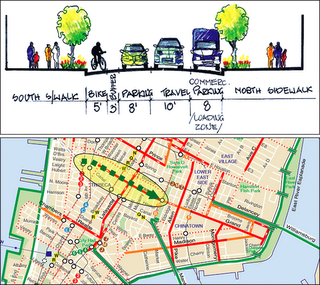 In towns and cities across the nation, there's a change in the air. It may be a subtle breeze at the moment but communities are improving their bicycle infrastructure, making bicycles a practical & fun transportation alternative and sparking a true bicycle renaissance in the process. (Image right: bikeways in Lower Manhattan)
In towns and cities across the nation, there's a change in the air. It may be a subtle breeze at the moment but communities are improving their bicycle infrastructure, making bicycles a practical & fun transportation alternative and sparking a true bicycle renaissance in the process. (Image right: bikeways in Lower Manhattan)Studies have shown that when it's safer and more convenient to get around by bike, more people go cycling, lowering motor vehicle congestion and greenhouse gas emissions while fitness improves and neighborhoods are revitalized. Still swooning from the effects from Katrina, this could be just what New Orleans needs to flower again.
The Big Easy has long held the potential for being a bicycle friendly community. Flat and compact, New Orleans should be ideal for living car free; however, a gumbo of issues has prevented all but the most determined cyclists from using their bicycles for more than occasional recreation. But the situation is improving considerably.
Over the next 2 years, 50 miles of new bike paths and lanes will connect city neighborhoods in a bicycle network that will allow most New Orleans residents to commute by bike.
Over the next year, work will begin on the exciting Lafitte Corridor bike path and linear park connecting the French Quarter to Delgado College, City Park & Lakeview. Additionally, New Orleans' director of Public Works Robert Mendoza noted recently that the Robert E Lee bike lane should reach within a few short blocks of the University of New Orleans campus and that 2 additional bike lanes on major connector routes should be complete by this time next year.
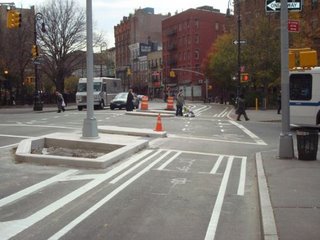 Yet New Orleans is not alone. With half of all trips people make in the US being no longer than 3 miles long, it should come as no surprise that major improvements in bicycle infrastructure are taking place across the nation.
Yet New Orleans is not alone. With half of all trips people make in the US being no longer than 3 miles long, it should come as no surprise that major improvements in bicycle infrastructure are taking place across the nation.Look at New York City. The Manhattan Waterfront Greenway, Eighth Avenue cycle track (photo right), Broadway Bikeway and various other bike lanes are all soon to be complete. Had Mayor Bloomberg gotten his way, even more projects would be taking place.
To spotlight all the bike paths, lanes and routes that are being created in the USA, I plan to post updates regularly with info about various projects and links to additional info. Stay tuned...
Thursday, November 20, 2008
Folding Bikes & Bike Trailers
As practical as folding bikes are for commuting or running errands, there are limitations when it comes to toting goods (such as groceries) on any bicycle, especially a compact fold up bicycle like the Carry Me, E-Z Pack, Kent Compact Nexus or Mobiky. In such cases, attaching a trailer to your bike can work wonders.
Slideshow:
Compact Nexus folding bicycle w/bike trailer attached
By placing the weight of your cargo on the trailer instead of the bike, the right cargo trailer can maximize the practicality of your bike. You'll gain stability & responsiveness, reduce your carbon footprint and avoid breaking spokes, warping rims or blowing tires.
After trying a variety, the bike trailer I like best for carrying cargo is Tony Hoar's Grocery Getter (GG). The GG is unique for a variety of reasons.
Watertight, Practical Cargo Container
The Grocery Getter's frame is built to cradle an 18 gallon RubberMaid tote. The result is a weatherproof cargo container that is stackable, easy/economical to replace and a breeze to remove (so goods can be carried right into your house without walking back and forth several times). With a carry capacity of 150 lbs, chances are that the GG can hold more than you would ever want to pull. And if the tote cracks, Walmart normally has them for $6.
Stable Transportation Platform
The GG transports cargo between two 16" wheels, allowing cargo to be carried with a lower and far more stable center of gravity. The hitch is mounted to the seat post instead of the rear axle, allowing the trailer to track properly when turning and turn in less space. And if you have a folding bike with small wheels, the GG's seat post mount allows the trailer to attach when other trailers never could.
Less Packaging & Handling Needed
Unhitch the Grocery Getter from your bike and it becomes a hand cart (the hitch bar has foam padding so you can pull or push the trailer comfortably by hand). About the same width as a standard sized shopping cart, the trailer is easy to manuever down the grocery aisle. Once you're done with the cashier, the purchases remain in the cargo tote until you're ready to put them away in the pantry, making it possible to completely forego the epic "paper or plastic" issue.
Stores Compactly
The Grocery Getter's designed so that all parts of the trailer will fit inside the RubberMaid tote for storage.
Ultimately, having the right trailer will increase your opportunities for cycling, giving you more enjoyment, keeping you fitter and reducing your carbon footprint even more.
Priced at about $300, the Grocery Getter is a good value for the ways it can improve your life but it's not cheap. Tony and I have been talking about ways to reduce the cost while improving the product. Mass production with tight quality controls would do it but the start up costs for that are daunting.
Ultimately, the answer lies with consumers like you. What would you pay for a cargo trailer that goes just about anywhere. Post a comment with your answer now. Who knows; you just may get your wish in 2009.
Negotiating The Hanoi Traffic Jam - Part 2
Part II
By Richard Pierce
Editor's Note: This is the 2nd part of a story about the state of urban transportation in Hanoi, Vietnam. In this portion of his story, Richard gives his answer regarding how to encourage Indochina's consumers to embrace green, non-polluting transportation - lead by example. If you missed it, here's a link to Part I of his story.
The history involved in answering that question is far more than any folding bicycle ever asked for and only evokes terms like "murky", "nebulous", and "confusing". The Indochina Wars proved the socio-political volatility of the region and it is obviously not an environment conducive to high-minded talk of saving the air. It is impossible to give the details without sounding like an Orwell paper, but here goes.
The French colonial era (and I'm already omitting 1,000 years of Chinese occupation before the French) gave way to World War II, which, in Asia, was exacerbated by a policy among the last governors of screwing things up as much as possible. Then there was a brief Japanese occupation, which sparked a famine in Vietnam. East Asia, except for a few Islands of British hegemony like Singapore and Hong Kong (and a de-fanged Japan under US control), then devolved into communism. That then failed due to incompetent land reform and corruption, and the Soviets had to prop Vietnam up with subsidies, which they promptly withdrew in 1986, forcing the country to quietly go capitalist.
No one's quite sure how it's all being governed now. Assume all of the above minus the Soviets. That leaves an absolutely gigantic mass of people, 85 million by last count, trying to make sense of their world, make a little money, and enjoy themselves before the next war. What does that mean in terms of trying to get more people on folding bikes?
The murky explanation has to resume for a bit here: the Vietnamese were already riding bicycles because they had no choice, until, again, 1986. (Remember all those photos in the news magazines in your parents' attic, of young women in ao dai dress pedaling through the rice paddy?) Then came the US' and other bilateral trade agreements, and with them the fleeting prosperity of today, which people demonstrate by buying a motorbike or car. Most Vietnamese would just as soon never be seen on a bicycle again and there is virulent disdain among the nouveau riche for real peasants in their conical hats, flooding onto the cities, hawking tomatoes from rusted-out, brake-less three-speeds that may very well have the ones in those photos.
The average age in Vietnam is around 30 now, they are more highly paid, and they love expensive European things. Even though they still live at home with several generations of the family, they will spend all of their money on a five-thousand dollar Vespa just to be seen on Saturday night. But there may be a way to make use of having entrained 85 million people in Western consumerism.
I do see more folding bikes each day, although people still think they're for children, paint them bright colors, and install plastic spoke covers with teddy bears, flowers, or lightning bolts on them. I want to believe, however, that these kids will grow up and remember their folders fondly, and somewhere in this spun-around little world, associate them with reduced carbon emissions. A lot, however, has to happen first, like broadcasting the message in awareness-raising campaigns that motor vehicles create harmful emissions and bicycles don't.
The United Nations Environment Program, IUCN, WWF, and some others are tapping young people too, and they're finding that there is a healthy respect for sustainable development. It's just a sprig now, and survives entirely on foreign funding, but it is there and the Vietnamese will probably take the ball and run with it as their cities are increasingly flooded during the monsoon by rains that even they have never witnessed in thousands of years of living next to a shallow, warm sea.
Two weeks ago, Hanoi had its worst flooding in 20 years and I saw, for the first time in my life, a drowned person. It was in a small lake in my neighborhood that had overflowed, by coincidence, the same lake that John McCain had parachuted into before they put him in the old Maison Centrale, the 'Hanoi Hilton', also called Hoa Lo Prison (which now has an office tower financed by Singapore at one end and a refurbished guillotine at the other to show the tourists).
The key is to get people to see that their personal transport is the place to start. They haven't reached the stage where they are asking themselves what effect the gasses coming out their tailpipes have on their own air, and that would be the natural place to insert folding bikes. But style is everything here, and while images of chiseled Dutch men and women tooling to work on their bikes in Amsterdam may exert some kind of influence on the psyche of the emerging Asian super-class, it still isn't as cool as a pink Vespa.
So I take it one commute at a time. I ride my Dahon, made, ironically, here in Asia, through the middle of the traffic jams and people get a kick out of it. The bike advertises itself and people treat me better. They recognize immediately that it's practical. The Vietnamese also love quirky gadgets that you can pack up and take into your 10sq.m flat. But will folding bikes ever have a meaningful opportunity to prove themselves amid the mind-boggling urbanization? Based on what I've observed, yes.
It's already nearly impossible to get through intersections on a good day and permanent gridlock is not far off. In which case, there is little more we need do other than continue riding through those traffic jams on our folders. In a hundred years they'll look back and call it the "Folding Revolution".
Richard Pierce is in Hanoi doing work for Family Health International (FHI), one of the largest and most established nonprofit organizations active in international public health. FHI's mission is to improve lives worldwide through research, education, and services in family health. To learn more, visit FHI.org. By the way, Richard ordered an E-Z Pack folding bike because he wanted something lighter and more compact than the Dahon he's been using.
Wednesday, November 19, 2008
Negotiating The Hanoi Traffic Jam
by Richard Pierce
I live and work in Hanoi, Vietnam and I commute to work on a folding bicycle. If you've been to Hanoi recently, or have seen it in the news, you'd probably say that this is tantamount to suicide, and you'd be correct. As Asian cities develop, the streets are literally becoming impassable with motorbikes and cars. Infrastructure is not catching up because inept officials steal or waste all of the funding before it goes where it's supposed to, and each day more and more people stuff themselves onto roads that are not growing to accommodate them. They regard red lights as an electric thing next to the road that makes a nice color as they blow past.
Then at the other extreme there is Bangkok, now 'over-developed', which doesn't suffer so much from inept planning as from a penchant for directing eight-lane motorways through the city center at ground level. This creates too much space, which invites another problem: when there is a freak instance of open road, cars immediately accelerate to triple digits as if it were possible to go faster than the earth is spinning and get back to where you would have been were there no initial delay. In Jakarta, meanwhile, it takes two hours minimum to get anywhere by taxi during rush hour and people miss entire meetings just to cover a few hundred meters. (By the way, none of this is researched or fact-checked. I live it.)
The air pollution is beyond belief in all of these places. At stoplights here in Hanoi the fumes actually distort your vision like the heat off a desert road and I once saw a lorry driver roll down his window and vomit for lack of real air. Public transport is too little too late and in most cases just makes things worse particularly because city traffic authorities buy used busses from post-developed cities with diesel engines that have already done several hundred thousand miles and definitely smell like it.
Riding through the middle of this is me on my 'folder', one less person worth of crowding and carbon monoxide. I would obviously like to stop being a minority, but how do you tell people who have been poor for centuries, attacked, invaded, colonized, and ruled by despots that just as soon as they get enough cash in pocket to improve their lot with personal motorized transport, they can't because the West has already brought us to the brink?
Editor's Note: For Richard's answer, see Part Two of his story.
About Richard Pierce
Richard Pierce is in Hanoi doing work for Family Health International (FHI), one of the largest and most established nonprofit organizations active in international public health. FHI's mission is to improve lives worldwide through research, education, and services in family health. To learn more, visit FHI.org.
Folding Bikes In Emerging Economies
by Larry Lagarde
Last month, Richard Pierce, a Family Health International aid worker in Vietnam contacted me. He was looking for a good quality folding bike but all the folding bicycles available at shops in Hanoi were of very low quality. He wanted something that was beefier and would hold up on the rough streets of Vietnam's capital. Specifically, he wanted to purchase an E-Z Pack folding bike. He wrote...
I've discovered that the bikes that China makes for Western markets and those that it makes for Southeast Asian markets are two vastly different things. There is one single model of folder available here in every single shop and it's rubbish. They just paint it a different color and put a different nonsense label on it, or worse, a fake "Dahon" label. The quality of the welds, the paint, the quality of the plastic, etcetera, it's all low. As soon as you get it home it starts to break.Initially, I was skeptical; however, over the course of some correspondence, I realized that the request was real. We were able to work out the details and I shipped the bike off but with one request - that he write me more about the transportation situation in Hanoi. And he did.
By the way, if you're wondering why the surge in popularity of folding bikes worldwide, based on what I've seen here in Asia: overcrowded roads, pollution, and hard economic times. People actually have no choice.
Yesterday, I received an amazing story of what it is like trying to get from place to place within Hanoi. Titled "Negotiating The Hanoi Traffic Jam: Folding Bikes Take Their Place In Post-Modern Indochina", the story is a telling reminder of the huge challenge the world faces regarding the reduction of pollution, congestion and global climate change.
Due to the story's length, I'm publishing it in 2 parts. Here is a link to Part One. If you have a moment, it's definitely worth reading.
Tuesday, November 18, 2008
1st Glance - 2009 Nexus Folding Bike
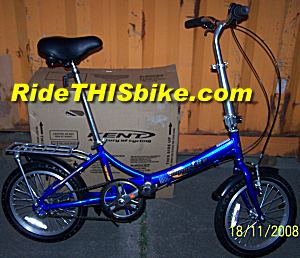 The 2009 Kent Compact Nexus (Superlite Aluminum) 3 speed folding bikes have arrived here. I pulled one from its shipping carton and went for a short ride this evening. Here are my impressions.
The 2009 Kent Compact Nexus (Superlite Aluminum) 3 speed folding bikes have arrived here. I pulled one from its shipping carton and went for a short ride this evening. Here are my impressions.The Kent Compact Nexus is a basic, no nonsense, bike that folds for easy storage and/or transport on buses, subway, etc. Designed for commuters, boaters and for running errands in the neighborhood, this sturdy folding bike has an exceptionally low pass through, making it easy to mount and dismount. The bicycle is equipped with an adjustable height folding handlebar stem and seat post, rear carry rack, fenders, kickstand and folding pedals.
The Compact Nexus folding bike ships completely assembled. Including all the standard accessories, the bike weighs about 26 lbs, making it light enough to pick up and carry when needed (such as going up/down stairs).
No Assembly Required
Once I pulled the bike from the carton, it was simply a matter of pumping up the tires and tightening bits left loose to prevent damage during shipping (such as the quick releases, brake lever handle, grip shifter and reflectors). Ten minutes after opening the carton, I was riding the bike.
First Ride Impressions
I only had a moment so I simply rode the bike down the street. The bike shifted perfectly into every gear. Although the coaster brake and front brake worked well, there was some squeal from the coaster brake (but this should disappear with use).The bike accelerates well and appears to cruise at about 14 mph. Once I put the GPS on and go for a longer ride, I'll know more. Hopefully, that will be tomorrow.
Likes
Love the Nexus drivetrain; it's simple, efficient and quiet.
Brakes function well; coaster brake allows for long lasting, hands free braking.
Upright ride is comfortable; frame geometry offers good power transfer.
Low pass through makes it easy to get on or off the bike.
Beefy handlebar stem means less stem flex.
Nice blue color.
Dislikes
Fenders are cheap plastic; they'll do but wish they were nicer.
Stock folding pedals are single sided and heavy (optional, lighter dual sided pedals available though).
Most Similar Folding Bike
The Dahon Curve D3 is the closest folding bike to the Kent Compact Nexus. I find the Kent's Nexus hub superior to the Curve's Sturmey Archer (but only slightly). The Dahon comes standard with higher pressure tires (for a faster cruising speed), better fenders and an air pump BUT the Dahon is TWICE THE PRICE too. If you're looking for great value and practicality, the Kent Compact Nexus is the bike to buy.
Monday, November 10, 2008
Desert Sand Folding Bike Carry Bag
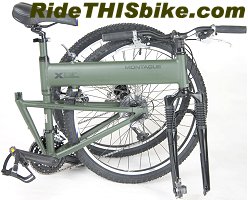 by Larry Lagarde
by Larry LagardeThere are times when customers ask me for unusual products. Recently, a U.S. soldier deployed in Iraq wanted a camo colored carry bag for his Montague Paratrooper folding bike. Although Montague makes a great carry bag (they call it a soft case), the Montague bag is black with either "MONTAGUE" or "SWISSBIKE" in big, bold, white letters -not the best color scheme for desert warfare, bow hunting, etc.
Today, a firm that makes nylon back packs contacted me looking for some business and it got me thinking about making a desert camo or green camo colored carry bag for the full size folding mountain bikes from Montague.
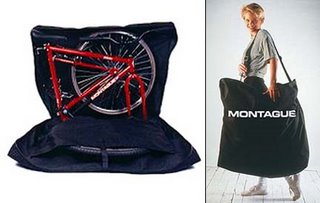 I asked the back pack manufacturer if they could come up with something for me and I hope to have an answer soon. The real question though is whether there's enough demand for such a specialty product.
I asked the back pack manufacturer if they could come up with something for me and I hope to have an answer soon. The real question though is whether there's enough demand for such a specialty product.Would you buy a camo colored carry bag for your folding bike? To produce a product like this at a fair price will take more than a couple of orders from a few Special Forces guys... The target price is a max of $149. If you're interested, just let me know.
By the way, another question I get is whether I can paint the Paratrooper, SwissBike LX or one of the other less costly Montague folding bikes (like the Montague CX) in desert cammy. This is something that I've toyed with doing. It does require pulling parts to do it right and the rear rim sidewall cannot be painted; however, I'm game if enough people are interested.
Friday, November 07, 2008
Kent Compact Nexus 3 Folding Bike
by Larry Lagarde
After months of restless waiting, the latest Kent 16" folding bikes have finally arrived at Kent's main U.S. warehouse. Known as the Kent Compact Nexus 3, this folding bicycle is essentially the same bike as the Kent Compact 16-6; however, it has the quiet, maintenance free, Shimano Nexus internal gear hub (3 speed model). The other 2 differences are that the Kent Compact Nexus 3 also has a rear coaster brake instead of a rear v-brake and is blue in color.
Since RideTHISbike.com is the exclusive retailer for the Kent Compact Nexus folding bike, Kent will begin shipping these to me on Monday. I expect to begin shipping bikes to customers within a week of having these bikes in stock.
To kick off the launch of this great little folding bike, I've decided to include the optional carry bag FREE of charge for all orders received within the next 14 days. That's right - you'll receive a sturdy, practical and light aluminum alloy folding bike with carry rack, padded comfort seat, fenders, kickstand, adjustable height & foldable handlebar stem, carry bag AND shipping (within the USA lower 48 states) all for just $259.
Without a doubt, the Kent Compact Nexus is THE BEST VALUE folding bike for your money. To get a bike of similar quality and components, you'd have to pay twice the price.
Due to the high demand for Nexus gear hubs, only a small number of these bikes were produced. If you want one, place your order now.
Wednesday, November 05, 2008
Opportunities Amid Panic And Uncertainty
Like an impenetrably thick cloud of dust, panic and uncertainty linger over the world's economies.
In the wake of deepening world recession and the most serious international financial crisis in most lifetimes, people around the globe have been cashing in their holdings of rubles, yuan, pesos, rupees, etc. for positions in the good 'ole US dollar. According to some sources, 1000's of factories in emerging economies like China are closing every week. What is the average Joe to do? Look for opportunity because buddy, it's knocking.
Exhibit 1: Barack Obama
Barack Obama has rocketed out of nowhere to become the first black president of the USA. Using a steady call for change, Obama accomplished the seemingly impossible by capturing the attention and imagination of the young and disenfranchised. As the savings of America's middle class evaporated into the ether, Obama's call came to resonate across the board, leading to a landslide victory. But Obama's message has reverberated beyond the boundaries of the USA. Now, the world is looking to Obama with hope towards better times.
Exhibit 2: $2/gal Gasoline
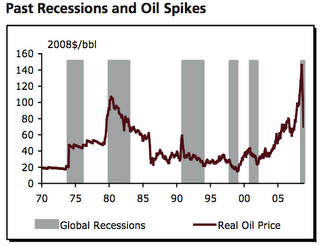 Since the 1970's, rising crude oil prices have been triggers in 5 out of 6 global economic recessions. Once crude prices begin to fall, every global recession in at least 30 years has ended within 3 years. With crude plummeting from it's all time high this July of $147/barrel to it's current price of $62, the clock on this recession has begun to wind down. Why? Because sharply lower transportation costs makes it cheaper to bring goods to market, giving manufacturers room to lower prices, stimulating sales and profits.
Since the 1970's, rising crude oil prices have been triggers in 5 out of 6 global economic recessions. Once crude prices begin to fall, every global recession in at least 30 years has ended within 3 years. With crude plummeting from it's all time high this July of $147/barrel to it's current price of $62, the clock on this recession has begun to wind down. Why? Because sharply lower transportation costs makes it cheaper to bring goods to market, giving manufacturers room to lower prices, stimulating sales and profits.Exhibit 3: DOW Industrial Average Leveling Out
 The DOW Industrial Average has been going nuts since 1994, trading from 4000 to over 11000 in just 5 years. After readjusting in 2002-2003, it began climbing like crazy again, rising in October '07 to a never before seen high of over 14000. Obviously, a realignment was coming and the one we had last month was huge but there is reason for hope. The DOW has risen 1000 points from its October 27th low of 8175, due to the resolve that was displayed by the U.S. federal government via the huge $700+ billion bailout package.
The DOW Industrial Average has been going nuts since 1994, trading from 4000 to over 11000 in just 5 years. After readjusting in 2002-2003, it began climbing like crazy again, rising in October '07 to a never before seen high of over 14000. Obviously, a realignment was coming and the one we had last month was huge but there is reason for hope. The DOW has risen 1000 points from its October 27th low of 8175, due to the resolve that was displayed by the U.S. federal government via the huge $700+ billion bailout package.Nobody knows how long the economic crisis will continue or how bad it will get; however, things are already improving. Companies are becoming leaner and more productive. People are refining their job skills to increase job opportunities in our innovation and tech driven world. The war in Iraq will soon end, freeing hundreds of billions in tax revenues from being thrown away in Iraq. The development of affordable, alternative energy solutions will decrease dependence on foreign oil and the transfer of America's wealth to the nut jobs of the world. Housing prices are stabilizing, costs of living are falling and healthcare will improve.
The key really is change. We as a people must be more prudent with our wealth, investing in our future by increasing savings and decreasing what we owe. We need to live within our means rather than mortgage our kids' futures. Instead of paying dues to a health club, ride your bike regularly to work. With the newly passed Bicycle Commuter Act, you can even get a bike for free courtesy of reimbursements through your employer. This could even lead to doing away with your car completely, saving most people $8000-15000/yr (per AAA). My point is that we all need to act with more responsibility. The sooner we do, the sooner this mess will be over.
Tuesday, November 04, 2008
UK Gadget Show Reviews Folding Bikes
 Brompton vs. Strida vs. SwissBike LX
Brompton vs. Strida vs. SwissBike LXThe Gadget Show (a television program that is produced for the UK's Channel 5) recently did a comparative video review of folding bikes from Brompton, Strida and SwissBike.
For the review, show host Jon Bentley enlisted the help of Rebecca Romero, the female cyclist that took the Gold at the 2008 summer Olympics in Bejing. Jon and Rebecca each rode a Brompton M3L, Strida 5.0 and a SwissBike LX and traded impressions of each bike while they rode.
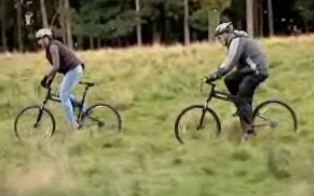 As the winner, they chose the Brompton for it's "classic, timeless looks", ease of folding/unfolding and ride; however, the SwissBikeLX was a close second place. The reason: the SwissBike's larger folded size, the need to remove the front wheel and the bike didn't roll when folded. They did like the SwissBike's ride and the SwissBike was the only one they could ride off road.
As the winner, they chose the Brompton for it's "classic, timeless looks", ease of folding/unfolding and ride; however, the SwissBikeLX was a close second place. The reason: the SwissBike's larger folded size, the need to remove the front wheel and the bike didn't roll when folded. They did like the SwissBike's ride and the SwissBike was the only one they could ride off road.Watch the full folding bike review
Larry
Voting Via Folding Bike
When are you going to vote today?
All across the USA today, it's decision time. Chances are, if you see a long line of people spilling out of a public school, etc., they're probably waiting to cast their vote for president. But many have already voted in this historic election.
At 9am this morning, I was ordering a new skylight at Home Depot (replacing one that was damaged by Hurricane Gustav). Two of the three cashiers I spoke with had voted. One was in line at the polls at 4:40am. The polling location didn't open until 6am and she was the 8th person in line.
Without a doubt, there's a lot of excitement over this election. In Florida, 38% of registered voters voted early - AMAZING! At 10 am this morning (a time when activity at the polls is typically low), I passed my polling place on the way home and there must have been 100 people in line.
It's just after 2:15pm now and in a few minutes, I'll be heading back out on my folding bike to cast my vote. Regardless who wins, the USA will have either it's first "black" president or woman vice president. Whether this feel good moment really matters in the big picture remains to be seen but I'm playing my small role regardless. I encourage you to do the same.
Tuesday, October 28, 2008
Cycling in Vegas Via Folding Bike
Note: This is one of a series of posts concerning InterBike 2008. Read the preceding story about carrying a CarryMe on Southwest.
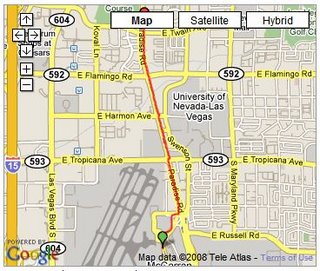 Last month when I attended InterBike, I flew to Las Vegas with a CarryMe DS folding bike as carry on luggage. The bike served as my transportation in Vegas; here's a recap of the ride from the airport in Vegas to my hotel.
Last month when I attended InterBike, I flew to Las Vegas with a CarryMe DS folding bike as carry on luggage. The bike served as my transportation in Vegas; here's a recap of the ride from the airport in Vegas to my hotel.Once the plane reached the gate at Mccarran International Airport, I removed my bag from the overhead and exited the plane. Since my clothing was packed in the carry bag with the folding bike, there was no need to go to baggage claim. I simply walked out of the airport, unfolded my bike and began cycling to the hotel.
Rather than ride amidst the heavy mix of taxis, limo's, airport shuttle vans and cars, I biked along a sidewalk that I had seen the night before when I Google mapped the ride. As the sidewalk arced away from the airport terminal, it entered a beautifully green and peaceful oasis of trees and shrubs - a pocket park. What a contrast it was to ride there. Unlike the vehicle chocked, multi-lane airport access road, there was not another soul on that sidewalk path.
The park gave way to the colors that prevail in Vegas - various shades of desert sand. Paradise Rd. was crowded with traffic and there was no shoulder so I stuck to the sidewalk. Smooth and relatively free of debris, this was a wise choice. Traffic on Flamingo was heavy and fast moving; I was grateful that the stoplight there had a button actuated pedestrian crosswalk.
According to my Garmin 305 GPS, it took a total of 25 minutes to bike just under 3 miles from the airport to the hotel. This includes a stop to readjust the bag on the rear carry rack, walking around a section of sidewalk that was under construction and no less than 10 stops at intersections (mostly for traffic lights). Had I waited for a taxi or airport shuttle, I don't think I could have made it much faster, particularly since I biked right out of the airport and rode right up to the front door of the hotel.
Though rush hour traffic in Las Vegas was heavier than I anticipated, it was a breeze getting around on the folding bike. Other than a speeding taxi and a tourist bus, drivers gave me plenty of space but riding on the sidewalk was safer. In fact, here's a video of one of my rides between the expo center where InterBike was held and my hotel...
Other than when at InterBike or the Outdoor Demo, I pretty much had the CarryMe DS folding bike at my side wherever I went. Due to the bike's compact size when folded and it's light weight, never did I feel burdened by having the bike with me. I took the folder into casinos and restaurants; neither management nor security stopped me or asked that I leave the bike outside. When out of the carry bag, everyone seemed bemused by this unique little folding bike.
Kudos to Southwest
In an age when airlines are making it more expensive to take bicycles aboard their commercial flights, it's nice to know that at least one airline will let you take your folding bike aboard as a carry on. Kudos to Southwest for their reasonable baggage policies towards folding bikes as well as their great, friendly staff.
Learn more about the Carry Me DS folding bike
About Larry Lagarde Larry is a dad and folding bike enthusiast that lives in New Orleans. Whenever he travels, a folding bike always goes along.
Monday, October 27, 2008
Chainless Folding Bikes
For a long time, I've wondered why bicycle manufacturers cling to using drive chains. This is not an academic question; other options do exist and they are viable.
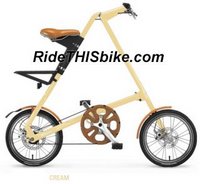 Although bicycles have used chain drives since the Safety Bicycle of the 1880's, Columbia's shaft driven bikes of the late 1890's were quite popular. More recently, Strida folding bikes have employed a kevlar drive belt since the first one came off the line in the late 1980's. Not only is the Strida's drive belt greaseless, it also lasts the life of the bicycle.
Although bicycles have used chain drives since the Safety Bicycle of the 1880's, Columbia's shaft driven bikes of the late 1890's were quite popular. More recently, Strida folding bikes have employed a kevlar drive belt since the first one came off the line in the late 1980's. Not only is the Strida's drive belt greaseless, it also lasts the life of the bicycle.Why I Hate Bike Chains: Dirt
Bicycle chains are dirt magnets. The dirtier they get, the faster they wear (and wear out the drive teeth on the cogs). If your bike has no chain guard or cover, the chain can (and will) get your clothes dirty or even get caught in them (and most employers are not very sympathetic about showing up at work in torn or dirty clothes).
Other Bike Chain Problems
If your bicycle has a derailleur, count on the chain coming off at some point. Hopefully, when the chain comes off, it won't get caught in the spokes, causing you to come to a grinding halt and tearing up a bunch of spokes in the process (yes, I've been there). Even if you clean and lube your drive chain every 250 miles (as recommended), the chain should be replaced every 2500 miles. Failing to do so will result in premature wear of the teeth on the sprockets, skipping of the chain and (eventually) chain failure.
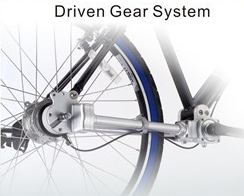 So why not use a chainless drive?
So why not use a chainless drive?Belt drives can slip under high load. Shaft drives are not quite as efficient as a new or well maintained chain (they also weigh about a pound more). But the big reason is the derailleur system of changing gears. For riding off road on rocky/bumpy mountain bike trails, nothing beats a multi-speed mountain bike with a rear cassette and derailleur.
Where And How Most People Ride Bicycles
The truth is that most bicycle riders are cycling at a moderate to easy going pace on relatively smooth and flat surfaces. Most cyclists with multi-speed bicycles only use a couple of their gears. Lastly, most cyclists don't even come close to maintaining their bikes as often as recommended. Herein lies the reason for chainless drives.
Given the realities of how many people use their bikes, chainless drives make tremendous sense. Going chainless means less maintenance with no noticeable weight or performance penalties when riding moderately or leisurely.
Readers have asked for a review of a shaft driven folding bike. There aren't many out there and the companies that sell them are small but I'll see what I can do.
Wednesday, October 22, 2008
BigFish Folding Bike Coming
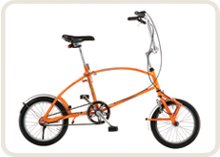 by Larry Lagarde
by Larry LagardeI just received word that a BigFish folding bike will be on its way here in a few weeks for me to review.
BigFish is the new aluminum folding bike on the block. Hailing from Slovenia (the Central European nation on the Adriatic Sea just east of Italy), the BigFish has the geometry of a standard sized bike; yet, it has 20" wheels.
Interesting Folding Design
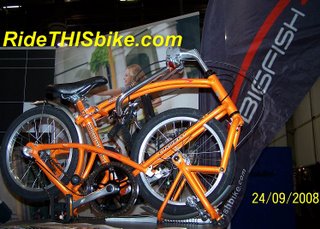 The bike folds down to 41" x 25" x 12" in 10 seconds via a unique process that keeps the main frame rigid, folding the front fork and rear sub frame instead. According to BigFish, this gives their folder the feel of a full size, non-folding bike and improves pedaling efficiency.
The bike folds down to 41" x 25" x 12" in 10 seconds via a unique process that keeps the main frame rigid, folding the front fork and rear sub frame instead. According to BigFish, this gives their folder the feel of a full size, non-folding bike and improves pedaling efficiency.From what I saw at InterBike 2008, I believe the BigFish will live up to its claims but we'll have to wait until I have the opportunity to take it on the streets of New Orleans. If you want specs on the BigFish, here's all that I have for now:
Frame: Aluminum, unfoldable
Gearing Mechanism: Shimano Nexus 3 speed internal geared hub
Lights: front and rear battery light
Brakes: front V-brake, rear pedal brake
Folded Dimensions: 64 x 104 x 31,5 cm
Weight: 28 lbs (12,5 kg)
Wheel size: 16"
Colors: Black, Orange or Gold
By the way, the BigFish is not yet for sale in the USA. In Europe, the bike sells for 599 Euros (about $770).
Tuesday, October 21, 2008
Living Well - It's A Choice
What did you eat for breakfast this morning?
Stress combined with a sedentary lifestyle and poor nutrition are a recipe for health problems. So what was my solution this morning when I awoke late and had to be dressed and out the house in 10 minutes? Why a Starbuck's Mocha Soy Grande and some dry chocolate Rice Krispies of course ;-)
Although my breakfast wasn't the greatest choice in terms of nutritional value, it made me alert so I could drive and was expedient. If only I had more time; right?
Our Choices Make Or Break Us
Too often, we lead our lives reacting to the immediate situation at hand and worrying about factors in life that we cannot control; yet, these are choices. Ultimately, each decision leads us to a seemingly endless cascade of choices that define us as the people we are.
If you are unhappy with your life or the last minute choices you are faced with, don't beat yourself up about it. Rather, accept responsibility for making your own life happier and take the steps that will get you there.
Figure out what ultimately led you to poor choices. Once you understand the underlying causes, you can map a plan that leads to better choices. Then it's time for the hard part - taking the steps you identified that will make you happy with your life and looking back every so often to be sure you're still on track.
Living well is a personal choice. If you want to be physically fit and emotionally well, there's no better time than now. Put yourself on the right track today.
By the way, if you want to improve your nutrition, US News & World Report published a story today titled "10 Things the Food Industry Doesn't Want You to Know" - interesting reading to be sure. Now go take a bike ride; that's what I'm doing!
Thursday, October 16, 2008
Folding Bikes & Mass Transit
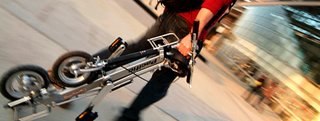 By Larry Lagarde
By Larry LagardeWould commuting via folding bike and mass transit be appealing? Commuter Ellen Babcock thinks so. She has no regrets about giving up commuting via her pickup for a multi-modal commute via folding bike and transit.
Reading Ellen's story, I wondered whether the same logic could be applied to even the most car centric metropolis. To get an answer, I contacted the Los Angeles Metropolitan Transit Authority (MTA) and learned that they're working on a plan to encourage using fold up bikes with the Metro.
According to an interview I conducted with MTA's Dave Sotero and Lynn Goldsmith, Caltrans recently awarded $85,000 to the Los Angeles County Metropolitan Transportation Authority to prepare a program to get more cyclists and motor vehicle drivers to ride L. A.'s Metro. How? By offering an incentive for using a folding bike in combination with the Metro.
MTA officials view folding bikes as a partial answer to 2 tough problems facing transit agencies worldwide: how to get more commuters to use mass transit and how to accommodate additional transit users. Like most transit agencies, Metro barely has enough funds to make ends meet. If they can convince more commuters to adopt folding bikes, transit administrators can improve infrastructure (as in buy more buses and subway coaches as well as build more Park and Ride facilities) in a sensible and affordable manner.
To fund the folding bike incentive program, Metro is studing similar projects like Santa Cruz's Folding Bikes in Buses program. The Santa Cruz program offsets the cost of acquiring a folding bike to use with the buses. A pollution mitigation grant from the Monterey Bay Unified Air Pollution Control District funds the Santa Cruz program.
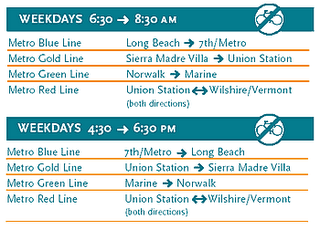 Although folding bike users can board MTA trains & buses at any time, restrictions exist for full size bikes and this has caused friction. In June, L.A. City Council President Eric Garcetti pushed for the MTA to drop the rush hour ban on full size bikes and even suggested that seats be pulled from Metro trains to provide more space for bicycles. Naturally, this did not sit well with non-cycling Metro users.
Although folding bike users can board MTA trains & buses at any time, restrictions exist for full size bikes and this has caused friction. In June, L.A. City Council President Eric Garcetti pushed for the MTA to drop the rush hour ban on full size bikes and even suggested that seats be pulled from Metro trains to provide more space for bicycles. Naturally, this did not sit well with non-cycling Metro users.Although folding bikes are not for everyone, their versatility makes it more practical for more people to use mass transit. Riding a bike right up to the transit stop, folding the bike and rolling it aboard often takes less time than driving and parking at a transit station. Keeping your 'last mile' transportation (folding bike) by your side also alleviates the worry of leaving your vehicle unattended at the station all day.
Although the MTA has funding to study a folding bike incentive program, funding the folding bike incentives is another matter. Nevertheless, Metro authorities hope to begin offering incentives to encourage more commuters to use folding bikes in a year or so.
By the way, Dave Sotero commutes regularly via the MTA + folding bike and has found that folding bikes easily fit in a variety of places on all of the MTA buses and trains. In fact, all credit for the photos displayed in the following slideshow (showing folding bikes traveling on the Metro) goes to Dave.
Monday, October 13, 2008
Mark Sanders Interview: IF Folding Bikes
An interview by Larry Lagarde
Recently, I had the opportunity to ask Mark Sanders some questions about the IF (Integrated Folding) bikes, a brand new series of folding bicycles being produced by Pacific Cycles. The center piece of the IF brand is the IF Mode, a radical yet incredibly clean looking bike that folds. Mark invented the IF Mode as well as the unique means by which it folds.
Here's a slideshow I created of Mark's personal, copyrighted photos and sketches regarding the IF project. The Q & A session I did with Mark is below the slideshow.
Q: How long have you been working on the Instant Folding or IF idea?
M: It has been 'an itch that needs to be scratched', ever since designing the Strida 1 (masters project) and X-Bike (consultancy project). After a break from bike design, I was invited by Steedman Bass, the new owner of the Strida IP (intellectual property) to re-design Strida 2. The new design aimed to make improvements and make the bike more suitable for far eastern manufacture. This work is what is now the current Strida 3 and 5 series. Compared to other products we design (medical, industrial, kitchen etc.) ... I found I really enjoyed designing folding bikes, because they are a such an interesting challenge, right on the cusp of engineering/structural design and user focused design ie they have to work well, be easy to use and be cool/appealing ! As a plus, I love using bikes myself.
Anyway, I did not start the new project properly until my company, MAS Design Products Ltd, had capacity between regular fee paying work, and could afford the time/money to 'indulge' (my wife’s term :-) ) in creating a new folding bike. This was 5 yrs ago in 2003. It took initially about 2 years of hard work to develop; Concept sketches, sketch models, models, CAD, FEA, prototypes, testing, repeat, repeat, etc.!; Patenting (supported by the British government); then some travelling for discussions with bike companies; more development, based on reducing costs and fitting in better with their process, and markets.
Q: What is the Swivel Head all about & did the IF concept flow out of the Swivel Head design or precede it?
M: The history was..
Having come up with the design, prototypes and patents for, what are now called the IF-Mode and IF-Cross, I courted some of the biggest players in the game. Most wanted to see the new technology (obviously), but getting commitment for the next, harder stage of manufacturing and marketing, was not easy. A few offers were made but without much real enthusiasm. Ming-Cycle knew me and were enthusiastic about adding a 2nd own brand, after Strida, their 1st own brand, and an early MAS Design. Ming are otherwise 100% OEM, and are in the top 10 global bike makers .... a large proportion of bikes sold in the US are made by Ming, under various brand names. However, Ming are not used to developing their own products, and later gave up the project to concentrate on their expanding OEM business. So the whole project was returned it to me.
Fortunately, in the meantime I had met George and Michael Lin, President and CEO of Pacific-Cycles. I was very impressed by their business; some of THE best mechanical engineering I've ever seen in the bicycle industry. Apart from extensive engineering and design skills, Pacific have, CAD, CAM, prototyping, testing, assembly heat treatment etc. all in one place. I learned they developed so many innovative folding bikes, many sold as other brands (eg Birdy, Airnimal). They also make mountain bikes, recumbents, special bikes, etc. for many other bike companies. Their own brands include the excellent 8” wheeled Carry-Me, and full suspension Reach ranges. Soon after Ming returned the IP to me, Pacific-Cycles, bought the whole project. Since then Michael and George, and their Chief Engineer, Ryan Carroll, have added their own bicycle engineering experience and excellence to re-design, improve and finalise the IF bikes for production.
'Swivel-Head' was simply the internal name Ming & I, first gave to the technology, when they had the patent. Now this is history, and IF for 'Integrated Folding' is both the name of the technology and the name of the brand. Both trade name and IP are 100% owned by Pacific-Cycles.
Q: Why design the IF Mode as a full size bike that folds?
M: Because although there are many excellent small wheeled folding bikes available, any straw pole, or even just observing cycle use anywhere will show 95% population choose and use full sized bikes. I am with you, other folding bike makers and enthusiasts in promoting small wheel folding bikes, but, I also feel that trying to re-educate the other 95% of the population is a bit like trying to swim upstream, hence this project.
Q: Wouldn't a folding bike with smaller wheels be better in terms of being compact and easy to store/transport.
M: Smaller IS easier to store, but not necessarily easier to transport, even 20lbs is very heavy to lug inside a shop, along a corridor or inside a train. Observing how luggage is now almost universally 'wheeled along' - I am convinced this is THE best way to transport a folded bike. Strida does just this, and it is now joined by the excellent Carry-me and Tikit folding bikes.
Also some small wheeled bikes just do not fold that small. The Brompton is THE best compromise, with a great folding ratio. But still, most importantly, even in Brompton’s back yard, London, 95% people prefer full sized bikes.
Some full sized folding bikes already exist, but these either; don’t fold without tools or unscrewing things like stems or wheels; are too large to easily take onto trains or into the office; or they are designed to be dismantled for packing, not really for multimodal travel.
Q: How long have IF Bikes been in field testing?
M: The Production IF Modes since March 08, early Pre-IF Mode prototypes since 2004, and IF Cross prototypes since 2005. and IF Reach Prototypes since 2007.
The IF-Mode was developed 1st, and the IF-Cross, 2nd to use a similar folding system in conventional frames, and in the IF Reach.
Q: Did any interesting surprises pop up while testing the IF Mode?
M: Yes, it fitted into bags and cases made for 20" folders.
Q: What reactions has the IF Mode gotten from people on the street?
M: Not much reaction in conservative UK, in fact it gets slightly less reaction than riding the triangle - Strida, until it folds, and then jaws hit the deck ... but by then, I'm gone ... onto the train ! In other countries, at bike shows in Far East, Europe and USA Interbike, people stop when they see the bike and crowds form when they see it fold .... Ryan can do the best demo, well under 2 seconds !
Q: The IF Mode's mono fork looks pretty slim from the front; can the bike survive daily use in a harsh urban environment?
M: Pedal axles have always been mounted on one side and take similar loads to wheel axles. So mounting a wheel on one side, with a similar tapered axle is absolutely no problem.
I really like the simplicity of one-sided wheel mounting, just like on cars. On a bike as well as the clean appearance, it also gives easy tyre changing and puncture repair. For folding bikes one-sided wheel mountings, allow the wheels to come closely together. So when folded they effectively form 'one wheel on a handle' - this feature is shared by both Strida and IF Mode.
Q: Do you envision any off-road versions of IF Bikes?
M: Watch THIS space !
Seriously, as Ryan has several suspension patents and Pacific-Cycles have developed a huge number of mountain bike and road bike systems - it is a real possibility. The IF Reach, already has full suspension - initially tuned for the road. IF-Cross will probably be the 1st to offer full off-road capability, it is already light and takes standard wheels, gears, brakes etc. which lend themselves to upgrades and off-road versions.
Early road going, non-suspension pre-IF Cross prototypes were tested extensively, on and off road and even on many downhill runs - I felt this was a good test for the technology ... (and very enjoyable).
Q: Is the IF series really targeted at non-cyclists?
M: Within the range of IF Bikes there is a bike to suit most tastes, from non-cyclists to cycling enthusiasts. The IF Mode is deliberately targeted at non-cyclists who like design, technology and do not necessarily want to change from their normal work clothes, or join a bicycle clan. Any cyclist who appreciates the design and folding benefits will also enjoy the IF Mode. The IF-Cross for is for existing or new riders, who want a bike that looks like and performs as any good full sized bike, it can be spec’d to be a perfect urban warrior! This bike is unique in it takes up to 700c wheels and can also fold, almost as fast as the IF Mode, without tools. It is also as compact as most 20" folders, and can be rolled into the office, shops and home. IF Reach adds the same folding, and rolling ability to the 20”, triathlete winning, full suspension, Reach. This means that this fast 20” bike can be also used for multimodal travel.
Q: Why would non-cyclists buy an IF type bicycle?
To get all the benefits of a modern folding bike. That is ‘take with me’ multimodal travel, small folded size, fast, ‘no tool’ folding, plus ‘rolls’ when folded (for easy portability), and the IF Mode and IF Cross are full sized bikes.
Q: Any chance of a 17 lb (8 kg) IF type folding bike in the near future?
M: Again - watch THIS space !
The IF-Cross in particular, can leverage 100 years of weight saving technologies, now applied to modern full sized road bikes.
Q: Any chance of a multi speed internal hub version IF model soon (such as with a Shimano Nexus 8 speed hub)?
M: Again - watch THIS space !
Pacific have the pick of all transmission suppliers, many of which are within a few miles of their factory.
Q: When do you expect that Batman style, remote controlled, servo assisted automatic folding bike to go into production (the one we discussed at InterBike)?
M: I am not sure about production, but I have some fascinating sketches and soon my CAD system will be buzzing with linkages, joints and lightweight actuators ! ... Don't believe me ? … They said the same about the fully automatic robotic Jar Opener which now sells in millions worldwide (but still not as interesting as a bicycle !).
Mark Sanders is the pricipal of MAS Design, a product engineering firm located in the UK. To learn more, visit mas-design.com.
Friday, October 10, 2008
Slide Show: STRiDA Mini folding bike
Displayed below is a slideshow of the new Strida Mini folding bike. Though interest in this new model has been high, supplies of the bike have been very limited. Before I ran out of them completely, I wanted to post more photos of the Mini online.
The brushed silver bike is the Strida Mini and the yellow bike is a Strida 5. By looking at the photos that compare the two bikes, you can see that the Strida Mini is a scaled down Strida 5.0. This was done so riders that are 4'4" to 5'4" tall could also ride a Strida.
Once the Strida Mini sells out, more are not likely to be available until early in 2009.
Strida Mini features & specifications
Wednesday, October 08, 2008
Bicycle Commuter Act Helps Americans
Shortly after passage of the Bicycle Commuter Act, grousing began about the Act being pork because it was part of the $700 billion Emergency Economic Stabilization Act of 2008 a.k.a. the bailout package (a reader even suggested the bike Act was another example why there should be a line item veto).
Though there's a great deal of disappointment with government and the bailout in general, the commuter tax credit embodied by the Bicycle Commuter Act is a good thing and here's why.
The Bicycle Commuter Act had one purpose - to correct a disparity in Section 132(f) of the IRS tax codes. The disparity was that the code allowed a tax credit to commuters that get to/from work via their personal motor vehicle, mass transit or van pooling; yet, offered no tax credit to bicycle commuters.
Due to the passage of the Bicycle Commuter Act, effective January 1, 2009, employees who regularly commute to work by bicycle can be reimbursed at a maximum rate of $20 per month for costs associated with commuting by bike. Allowable expenses include a bicycle purchase, bike improvements, repairs, and bike parking/storage. The reimbursements are to be made through the employer and employers have several choices regarding how to make the reimbursements. For example, employees can be reimbursed based on relevant receipts, may sign up for regular monthly payments or can work out a voucher system with their employer.
If you're wondering how the bicycle tax credit will prevent tax cheaters from abusing the credit, the IRS code will only allow a tax credit for one form of commuting. Since the reimbursements for bicycle commuting are far smaller than for other commuters ($215/mth credit for motor vehicle drivers and $110/mth credit for mass transit or van poolers vs $20/mth for cyclists), it would be silly for a car pooler, transit rider or auto driver to claim the bike commuting credit.
Given the high cost of healthcare, I'm glad that the bicycle commuter credit was included in the bailout bill. Business owners can now encourage their employees to bicycle to work, helping employees become healthier via their commute AND providing a tax break that will offset the cost of maintaining their commuter transportation (bicycle). In fact, we all stand to gain because this will mean fewer drivers, lower fuel consumption and less pollution.
And if we are heading into a depression, a lot of commuters may be using the bike tax credit ;-)
If anyone is interested, following is the exact text in the bailout package that pertains to the bicycle commuter tax credit.
Section 211 of the Senate Bailout bill states:
"(a) In General- Paragraph (1) of section 132(f) is amended by adding at the end the following:Note:
'(D) Any qualified bicycle commuting reimbursement.'.
(b) Limitation on Exclusion- Paragraph (2) of section 132(f) is amended by striking 'and' at the end of subparagraph (A), by striking the period at the end of subparagraph (B) and inserting ', and', and by adding at the end the following new subparagraph:
'(C) the applicable annual limitation in the case of any qualified bicycle commuting reimbursement.'.
(c) Definitions- Paragraph (5) of section 132(f) is amended by adding at the end the following:
'(F) DEFINITIONS RELATED TO BICYCLE COMMUTING REIMBURSEMENT-
'(i) QUALIFIED BICYCLE COMMUTING REIMBURSEMENT- The term 'qualified bicycle commuting reimbursement' means, with respect to any calendar year, any employer reimbursement during the 15-month period beginning with the first day of such calendar year for reasonable expenses incurred by the employee during such calendar year for the purchase of a bicycle and bicycle improvements, repair, and storage, if such bicycle is regularly used for travel between the employee's residence and place of employment.
'(ii) APPLICABLE ANNUAL LIMITATION- The term 'applicable annual limitation' means, with respect to any employee for any calendar year, the product of $20 multiplied by the number of qualified bicycle commuting months during such year.
'(iii) QUALIFIED BICYCLE COMMUTING MONTH- The term 'qualified bicycle commuting month' means, with respect to any employee, any month during which such employee–
'(I) regularly uses the bicycle for a substantial portion of the travel between the employee's residence and place of employment, and
'(II) does not receive any benefit described in subparagraph (A), (B), or (C) of paragraph (1).'.
(d) Constructive Receipt of Benefit- Paragraph (4) of section 132(f) is amended by inserting '(other than a qualified bicycle commuting reimbursement)' after 'qualified transportation fringe'.
(e) Effective Date- The amendments made by this section shall apply to taxable years beginning after December 31, 2008."
pension protection act, ppa, senate, bailout, HR 1424, bicycle commuting, qualified transportation, 132(f), ERISA
Special thanks go to Hillary Barbour in Congressman Blumenauer's office for providing clarification on this tax credit for bicycle commuters.
Saturday, October 04, 2008
IF Series Folding Bikes From Pacific Cycles
by Larry Lagarde
The IF is the new series of folding bikes from Pacific Cycles of Taiwan, a company that has been producing high end folding bikes like the Birdy, Reach and CarryMe. The IF series is a whole 'nuther ball game though and will soon be the new standard by which all folding bikes are judged. Here's why.
The folding bicycles in the IF series incorporate Mark Sanders' patented Swivel Head folding system, essentially two tensioned bars on either side of the 'top tube.' A quick release tensions the bars, making the frame super strong for riding. Open the quick release and the bike frame folds in 5 seconds.
Folded, the IF series bikes can be trolleyed like a piece of luggage. The handlebars and pedals fold too so the entire package is quite compact. In fact, the IF Mode is the most compact full size folding bike ever devised. Similar in appearance to the clay Cannondale Jacknife folding bike concept, the IF Mode has a mono fork and mono drop out on the rear wheel.
According to the Pacific Cycles' American distributor Alternate Vehicles, the first production run of IF Mode folding bikes will be here in a matter of months and I can hardly wait. I regularly ride a Pacific Cycles CarryMe DS and a Strida 5 for short rides (see my story about flying with a CarryMe as carry on baggage) and a Reach Trail for longer rides so I know the high quality of Pacific Cycles products and Mark Sanders' designs.
By the way, Mark Sanders and I talked at InterBike (he personally demonstrated to me how the Swivel Head technology works). Look for a coming interview with Mark here on RideTHISbike.com.
Rowed Trip Completed
Colin & Julie Angus have just returned to North America from their 7 month journey across Europe and into the Middle East by folding bike and rowboat. They bicycled and rowed from Scotland to Syria via Eastern Europe & Turkey. The trip took them through a total of 12 countries.
Sometime this week, I hope to talk with Colin about the adventure to learn more about the cycling portions of the trip. In particular, I'll be very interested in his thoughts concerning the full size folding bikes he used and any tips he has for others looking to journey great distances by folding bike. Meanwhile, here's a link to Colin's Rowed Trip blog so you can read more.